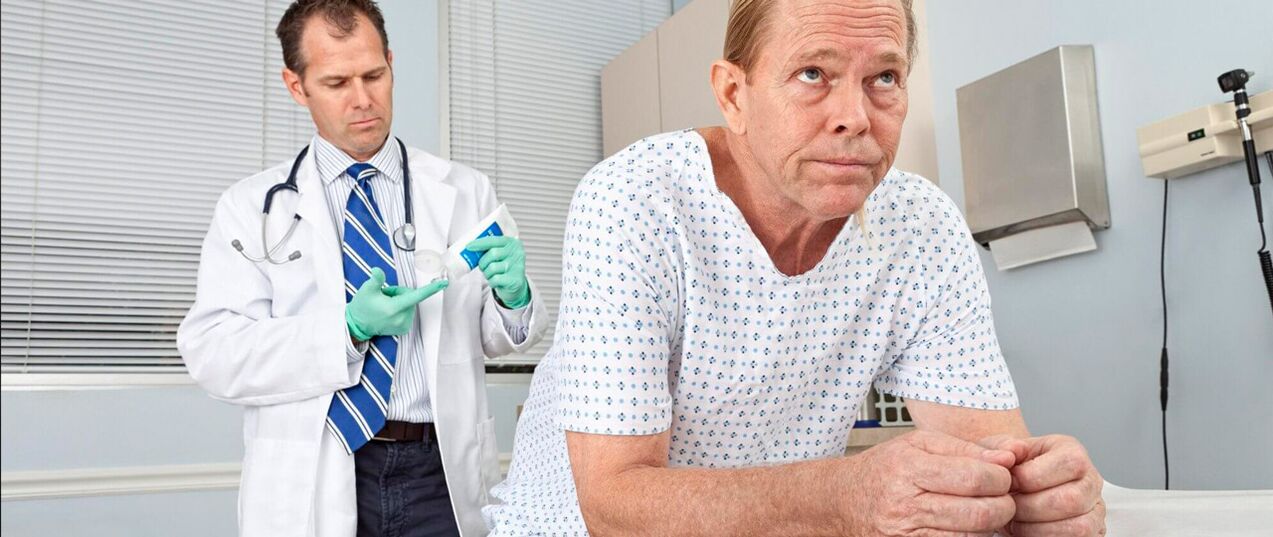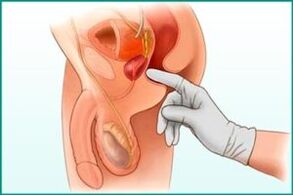
About half of the male patients who visit the urologist suffer from chronic prostatitis. Problems caused by a certain pathology worsen the quality of life, lead to depression and mental disorders.However, through a clear understanding of the functions of the prostate and the development mechanism of inflammation, we can correctly determine the symptoms and heal the disease in good time.
The meaning of the term "prostatitis"
With this term it is common to understand the development of the inflammatory process in the tissues of the prostate.Since it is only available in the male body, the disease in this category of the population is common.Its main function is the development of a certain liquid that is involved in the following processes:
- Forms and supports a certain environment in the urethra;
- Sperm diluted;
- Ensures the livelihood of sperm;
- Protects the genitarianrinary from infection.
Under the influence of a series of factors, the secretion of the secret slows down, which in itself becomes a violation.Prostate epithelial cells deserve regularly, but due to the congestion are not excreted, but accumulated that form microlytics - small pebbles.Covered by mucus, clog the glandular channels, which leads to the formation of small abscesses.During this time, the body continues to work normal, external negative manifestations are missing.
The progress of the process (accumulation of dense formations, an increase in concentration of the purulent content) leads to an increase in the organ and a compression of the ureters, the blood vessels and the nerve end.This is one of the causes of the disease.
Symptoms of the disease based on patient complaints
Already in the stage described above manifest the first signs that a man can only notice.Based on these changes, you can identify the development of inflammation at home independently.Of course, such a diagnosis is a note, but is regarded as a serious reason for contact with a specialist.
Self -diagnosis at home
What are the first signs of prostatitis in men?
Difficult drainage of urine.The compression of the urethral canal increased through the tissue of the prostate to its narrowing and as a result to prevent the outflow of the urine.The patient must apply a certain effort while urinating.
Exchange of urine.The calls to empty the bladder are becoming more common.First this happens at night, later a day.The man sees it on an additional cup of tea and continues to ignore the violations.
Pain in the lower abdomen.The symptom is a result of the accumulation of microlytes.The sensations become uncomfortable and are crushed, painful or painful.Your increase can occur until evening or after physical exertion.
Violations of erection and ejaculation.The syndrome occurs against the background of stagnating phenomena and rarely appears.If the patient drives this in tiredness and stress, he also ignores this sign.
Often the patient complains about a general deterioration in the condition, an increase in body temperature, which is also a sign of a development process.
The first signs of prostatitis in men require treatment, otherwise the process is initiated in a lengthy form.
Symptoms of acute inflammation
The insidence of prostatitis lies in the fact that it begins sharp and fast development without characteristic manifestations at the beginning, but then quickly chronic.

In order not to miss the moment and start the treatment in good time, a clear idea of the symptoms of an acute form is required.
- Fever, shaking frost.
- An increase in body temperature compared to critical values (39 ° C).
- Severe pain in the perineum, in lumbar and in groin business.
- Urine diseases - frequent and false efforts, a difficult urine outflow or its temporary termination.
- Pronounced poisoning - headache, weakness, pain in joints and muscles, tachycardia.
- Transparent or whitish discharge from the urethra.
The examination of the rectal fingers becomes impossible due to the formation of pain syndrome.In addition, it is contraindicated, since the examination may spread the spread of infection with blood flow and the development of sepsis.
Manifestations of the chronic relapse
Pathological processes of different types of illness can occur in slow form.Based on symptoms of patients and diagnostic data, experts distinguish the following signs of prostatitis of the chronic order:
- Complaints, moderate pain in the crotch, shine on the sacrum, the lower back, the scrotum, the weakness and the pain in the body.
- Heavy and rubber in the urinary channel during sexual intercourse or urination.The presence of purulent liner load from the urethra.
- Frequent urination, accompanied by a feeling of incomplete emptying at the end of the process.
- The inability to fertilize the lack of sperm, agglutination or increase the acid of the secret.
- Violation of ejaculation (extended prematurely or vice versa), pain or deleted sensations with orgasm.

Types of disease and the associated signs
Urologists distinguish several stages of chronic inflammation of the gland, of which each specific manifestations corresponds.
A characteristic characteristic for all types is a moderate pain syndrome in the pelvic floor.
| The form of prostatitis | Symptoms |
|---|---|
| Chronic bacteria | Dysuria, premature ejaculation |
| Pedal pain syndrome | Lack of other manifestations except pain |
| Inflammatory | Expressed problems with urination, symptoms in the genitals |
| Stagnate | In some cases dysuria, complaints |
| Asymptomatic | There are no clinical manifestations |
Professional diagnostics
The doctor can already determine the existence of inflammation of the prostate during a man's first visit.However, it is possible to determine etiology, level and complexity only with the help of instrumental and laboratory research.
Primary examination of the doctor
The anamnesis in the anamnesis is an overview of the patient and the analysis of external symptoms is one of the most important stages of diagnosis.During the conversation, the doctor determines the presence of clinical signs and the cause of the development of the pathological process.Here are the patient's lifestyle, the bad habits, the use of contraceptive methods and the presence of a sexual partner are important.At the same time, he directs the probability of existing diseases of close relatives and hereditary disposition.
The next step is a rectal finger examination of the prostate. Palpation is carried out to determine the parameters as to determine:
Palpation is carried out to determine the parameters as to determine:
- The size of the organ;
- Structure and contours;
- the presence of seals;
- Pain.
Laboratory tests
The next step is to carry out analyzes.This category is quite extensive, so only a urologist determines the need for each of them.
Oam kratusterizes the general condition of the urine system organs. The increased content of red blood cells, leukocytes and protein as well as the presence of mucus and other contaminants indicates an extensive course of the inflammatory process.
The urethra line is a painful and uncomfortable process, which, however, enables them to determine the presence of infections and to establish its variety.
The bacteriological sowing of urine enables you to identify the localization of the lesion, a variety of infections and the type of pathogen.
The cytological analysis of the seed fluid is carried out to determine your physical -chemical properties, mobility, activity and concentration of sperm as well as the dog's level.The biomaterial fence is carried out directly in the laboratory according to the prostate massage.
The condition of the procedure is sexual abstinence during the day.In the event of suspected chronic processing, this type of research is systematically carried out.
Symptoms recognized using instrumental diagnostic methods
Hardware methods are recognized as the most effective, which is due to the receipt of more precise and detailed information about the physical properties of the prostate and the alleged pathological changes in their tissues.They made the work of doctors considerably easier.
As a rule, only an ultrasound study is carried out by the entire biodiversity, and the rest of the methods are used when additional results have to be achieved.
Ultrasound is carried out to visualize the gland and determine its general condition, its size and consistency.The transrectal method is considered more informative - Truzi.A special sensor is inserted into the rectum with which you can determine what the organ looks like, identify tumors, adhesions, calculations, calculation, cystic formations and other pathological deviations.
The MRI is prescribed to determine the type of prostatitis and more in clarifying the previously obtained results, especially if some details remained unclear.
Urofloometry determines the speed of the urine current, the time to achieve its maximum value, the urine volume.It is carried out with a special device.
Cistoscopy with a thin probe makes it possible to evaluate the condition of the bladder and the urethral canal and to identify the alleged and existing pathological changes.
The biopsy is carried out in the event of suspicion of the oncological nature of the disease to rule it out.
The dangers of the asymptomatic course of the disease
Prostatitis that has no symptoms develops in patients in the older age group.

The reasons for his appearance are:
- Frequent hypothermia;
- Constipation and hypodynamy;
- weakened immunity;
- Acceptance of sexual activity;
- The presence of chronic pathologies.
The provocative factors are:
- Age of a man;
- Reduction of hormone production;
- Weakening of the protective functions of the prostate
- Degenerative processes in his fabrics.
The lack of treatment due to the impossible detection of the disease means the occurrence of such consequences:
- Persistent erectile dysfunction;
- Prostate tissue fibrosis;
- Development of kidney and liver failure;
- Urolithiasis;
- Benign hyperplasia of prostate, adenoma, cancer.
Documented an doctor: Complications
The risk of prostatitis lies in the rapid transition to a chronic form with greased symptoms and the lack of a clinical image that is expressed as in an acute course.
This form cannot manifest itself over a long period of time, which leads to irreversible processes in the tissues of the glands and different types of complications:
- Vesiculit, rear urethritis;
- Prostate abdress;
- Sclerosis of the glandular tissue and obstruction of the ryPreic channels;
- Polycystic formations;
- Development of the lime schools;
- Impotence and infertility, problems with conception;
- Pathologies of urine system - cystitis, pyelonephritis, urolithiasis;
- Nervous-psychogenic disorders, extended depression, acceptance of self-esteem.
Opportunities to relieve the patient's condition
Features of the selection of the therapeutic tactics depend on the type of disease, the form of origin and characteristics of the leakage.
Symptomatic treatment
Acute manifestations of the disease are extremely painful for the patient.Therefore, the priority task is to eliminate it.Medicinal treatment is used for this.In prostatitis, drugs in men are prescribed depending on severe symptoms:
- Antibacterial medication to remove the pathogen.
- Diuretics are drugs to stabilize the work of the bladder to improve urine outflow.
- Analgetics - remove pain in the head, joints and muscles.
- Anti-spasmodics and alpha-1-nine-grade ships for relaxing smooth muscles.
An effective dosage form is regarded as rectalic acids.Candles are used to alleviate acute symptoms:
- With an antibiotic that eliminates painful cramps and fought infectious manifestations.
- With NSAID's inflammatory processes.
- Analgetic with analgesic that improve blood microcirculation and restore the normal condition of the prostate.
Elimination of the cause of the inflammation
After acute symptoms have been stopped, it is necessary to start the therapy of the main manifestations.In this case, the treatment aims to remove the infection and restore the blood circulation.The following groups of drugs are used for these purposes:
- Antibiotics in tablets;
- anti -inflammatory medication;
- Immun modulators;
- Phytopers regulations.
If acute manifestations are not available, but there are signs of prostatitis in men, the patient continues to treat with physiotherapy, traditional medicine (pumpkin seeds, ginger and other medication), alternative methods (treatment with leeches, bee bakers, manual therapy).A positive result is often only achieved after appropriate performance correction.
Prevention of primary prostatitis and symptoms of worsening a chronic form
Despite the long duration of treatment, modern medicine is successfully connected to the elimination of prostatitis.
In men who have been transferred an acute shape or hardly recovered from the chronic current, it is important to adhere to preventive measures:
- Change of life change:
- regular walks;
- active sports;
- Rejection of bad habits.
- Restoration of normal sexual behavior:
- the choice of a reliable partner;
- Rejection of random ties;
- Regular sexual relationships;
- Protected sexual intercourse.
- Compliance with a diet:
- Rejection of fatty, fried, spicy foods;
- The use of healthy and natural products.
- Preventive examination by a doctor:
- Regular - once every six months - exams;
- existing therapy;
- Execution of gymnastics exercises.
Inflammation of the prostate is not a sentence in modern living conditions.Despite the severity and complexity of the electricity, a variety of clinical species can be treated perfectly.However, in order to avoid dangerous consequences and the development of serious complications, specialists must be contacted in good time.And for this you need to know all the characteristics of the signs and symptoms of prostatitis.

























